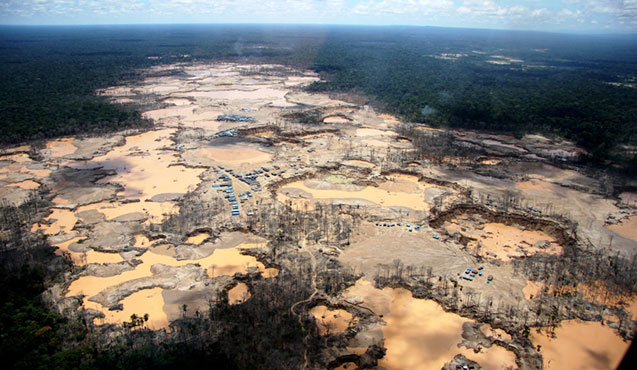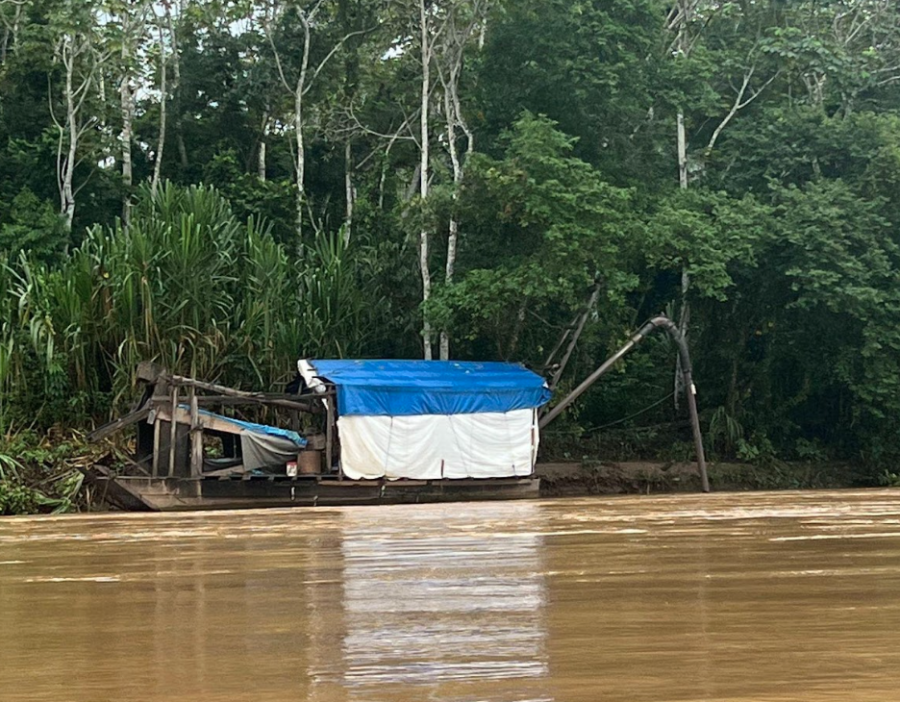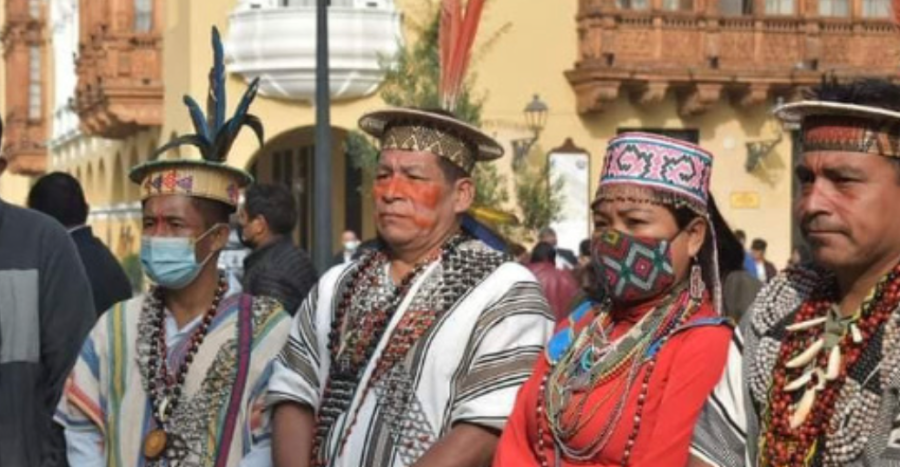The Amazon Rainforest in Peru has been subject to deforestation.
A controlled crash: Saving the damaged Peruvian Amazon
Eleven Wake Forest students studied Amazonian conservation in Peru this summer
August 24, 2022
After hours of hiking, 11 Wake Forest students broke through the dense vegetation onto a small cliff, exposing an endless expanse of rainforest stretched out beneath them. Clothes glued to their bodies by the wet air, they watched as storm clouds gradually approached them, drifting over the mountains to the north.
Gray streaks of rain poured onto the flatiron, which began the water’s inevitable journey to the vast Amazon basin below. Along the way, the water would pick up nutrients from the soil, serving as an essential mode of fertilization in this complex environment.
“We are standing on the last outlying ridge of the Andes,” Wake Forest Biology Professor Dr. Miles Silman said. “This is the last high point from here to the Atlantic Ocean, 3,000 kilometers away. You’re looking at the unbroken forest of the Amazonian plane.”
Silman has made this hike countless times. His annual visits to the Peruvian Amazon over the last 30 years have resulted in groundbreaking studies and a wealth of knowledge of the complex ecosystems of the Neotropics.
Over the few days prior, the group of study abroad students had traveled down the Rio Madre de Dios to Pantiacolla Lodge as part of a greater journey to see the wonder of the Amazon firsthand. Everything in sight was pristine forest, almost untouched apart from a handful of eco-friendly lodges and Indigenous lands.
But other parts of the Amazon are not so lucky.
Just outside of Manu National Park, which covers an area larger than Connecticut, pockets of the Amazon have been razed by deforestation and mining. Almost a fifth of the Amazon has already been destroyed, with the first three months of 2022 being the highest Amazon deforestation ever recorded, according to Brazil’s National Institute for Space Research.
These trends are threatening and currently impacting complex ecosystems within the Amazon, which are home to some 30 percent of the world’s biodiversity. This biodiversity is essential to the health of the rainforest, and by extension, the slowing of climate change on a global scale.
Gazing out at the untouched landscape, the study abroad students finally understood what conservation efforts aimed to protect — and what competing political and corporate interests aimed to reap for economic gain.
As global warming increases in tandem with deforestation, we are actively destroying an essential tool for mitigating the effects of climate change. Trees that sequester carbon are being cut down. Species are being driven extinct. Ecosystems that are foundational parts of global climate are being permanently damaged. Much of this is irreversible, but much can still be saved.
“If you don’t do anything, you know that things are going to be bad,” Silman said. “If you do something, there’s a chance you can pull it out. If the plane’s going to crash, you fly that thing all the way to the ground. You never stop.”
Dirty Gold
After staying in the park for another ten days, the group once again boarded a boat for a journey down the Manu River. They traveled downriver for two days, seeing only untouched wilderness. But the moment they crossed the border to exit Manu National Park, the river transformed.
Trash floated in the water. On the banks were huge piles of stones, remnants of illegal gold mining. Gaps in the forest canopy were frequent, huge plots of land completely cleared to make way for gold miners. Periodically, the group would pass a group of miners actively working along the river’s edge, a testament to the almost nonexistent enforcement of mining regulations.
Gold mining has plagued the Peruvian Amazon, largely due to a lack of government crackdown. This has not always been the case — in early 2019, the Peruvian government launched Operation Mercury, a program sparked by the newly publicized knowledge that gold mining was releasing huge amounts of toxic mercury into the air.
The program initiated a wave of military interventions in the Madre de Dios region to apprehend illegal gold miners and shut down their camps. These areas were hotbeds for other crimes, including gang activity, child labor and human trafficking.
Operation Mercury was a huge success, resulting in a 92% decrease in illegal gold mining activity, according to Amazon Conservation. However, three years later, the region has regressed.
Political shifts and a lack of broad support for the initiative have allowed illegal miners to retake the Madre de Dios. Thousands returned to the region with no one standing in their way, once again threatening the fragile Amazonian ecosystems and local public health.
There exists a process for miners to become officially formalized by the government, but due to low enforcement, there is little incentive for them to do so. Gold buyers even prefer to purchase illegally mined gold, as they are more familiar with the appearance of nuggets formed using mercury.
Wake Forest’s Center for Amazonian Science and Innovation, or CINCIA, was founded to combat these issues, aiming to serve as a reliable source of information on environmental issues in Peru. The NGO’s goals include reforesting damaged lands, providing research and education on mercury, and helping the mining process become more environmentally friendly.
“We do good, hard science here at CINCIA,” Dr. Carol Mitchell, deputy project director of CINCIA, said. “We are here to provide information; we are not an activist group. You can pick at science all you want, but it’s going to tell you the same thing.”
CINCIA has made efforts to engage with formalized gold miners in Madre de Dios to experiment with recovery options for destroyed land. There are thousands of gold miners, and only about 30 are currently formalized. CINCIA works with about 15 of them.
“The idea is not to say, ‘Oh, you’re a bad person because you’re a miner,’” said Cesar Ascorra, national director of CINCIA. “The idea is, ‘Mining has negative impacts, let us work with you to try to solve them.’”
After an area of land has been clear-cut and mined, the soil becomes nutrient-poor, making it extremely difficult for the forest to reclaim. CINCIA has developed an effective recovery strategy for deforested lands, using the shells of the common Brazil nut.
The group has found a cheap and effective way to make these nutshells the ideal fertilizer. According to CINCIA researchers, this burnt Brazil nut fertilizer, or ‘biochar,’ can remain in the soil for hundreds of years, playing host to various species of microbes that are responsible for fertilization.
Biochar has proven to be effective in field research experiments, drastically improving the growth of plant life in areas affected by mining. This recovery is critical to regenerating fractured ecosystems and preserving biodiversity.
Unfortunately, the effects of mining extend beyond reforestation. The rainforest is home to various Indigenous groups, who have faced immense struggle in making their voices heard by decision-makers.
Guardians of the Amazon
Indigenous leaders prepare to meet with current Peruvian President Pedro Castillo. One of their major concerns is representation in climate change issues.
Jaime Corisepa is the former president of the Native Federation of the Madre de Dios River and Tributaries (FENAMAD) and plays a key role in communicating the desires of Peru’s Indigenous peoples to the public and government.
Operation Mercury, despite reducing mining, forced many illegal miners deeper into the Amazon, some encroaching on Indigenous territories. This pushed many Indigenous people to move to new locations. As the Amazon is contaminated by outside interests, the innocent who have always called it home are facing the consequences.
Corisepa has sacrificed his normal life to serve the needs of his people, the Harakmbut. With a foot in each world, he must be an active member of his tribe while also acting as a sort of diplomat. He has attended various climate meetings and Indigenous rallies, all with the central goal of highlighting Indigenous perspectives on the climate emergency.
“The biggest misconception of the western world is that they think Indigenous people are just another object inside the rainforest,” Corisepa said. “We are forced to adapt to western ways of living. The western world has a lot of political, financial, and social strategies to force the Indigenous people to adapt to their ways of thinking and being.”
Because the Indigenous people are viewed in such a way, they are not appreciated for how they protect and care for the rainforest. Despite being there for over 5,000 years and serving as guardians of the forest, they are still often cast to the side when trying to make their voices heard.
Many Indigenous people hope to be represented on the Intergovernmental Panel on Climate Change (IPCC), the United Nations body that deals with climate change science and environmental issues. But they still struggle to be heard at even lower levels.
“We have our own physical and spiritual connection to the rainforest,” Corisepa said. “We need to be there [the IPCC]. The Indigenous people should be represented–we are part of these big decisions that affect the whole world.”
IPCC decisions and climate summits across the world will be essential to determining the well-being of future generations — an estimated 216 million people may be forced to migrate within their own countries by 2050 due to climate change, according to the World Bank on Climate Change and Health. Most of these people reside in low and middle-income countries which have little voice on an international scale, their fates being decided by world powers.
Protecting the Amazon is integral to the future of the planet, as it is one of the most crucial assets to slowing global warming. With preservation efforts by organizations like CINCIA and fair representation in climate policy-making, the invaluable rich biodiversity of the Amazon could be saved.
“There is hope.” Corisepa said. “As long as governments are willing to listen and learn, there is a future.”




Carlana Lane • Aug 25, 2022 at 7:13 pm
Well written study of a serious problem that is more than just a problem in the Amazon. It involves all of us in its ramifications.
Great article, Ben!
Peter Kann • Aug 25, 2022 at 3:09 pm
What a well researched and well written article. All the more impressive from a college student.
Professor Justin Catanoso • Aug 25, 2022 at 8:33 am
Great job with capturing so much of what’s experienced in the Peru program, Ben. Great job, too, OGB, with story layout and design.